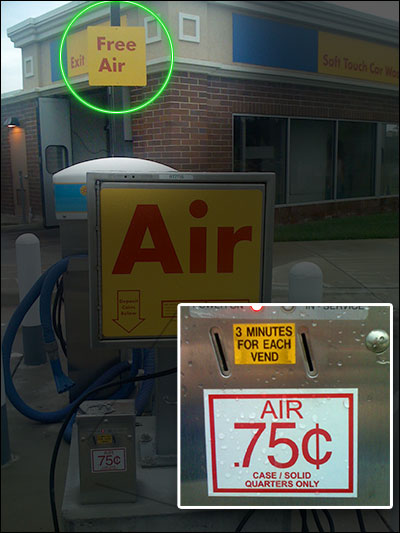Before we begin, let me say that I like Apple and that I had a very smooth transition to OS X 10.5 Leopard. I had the foresight to upgrade all of my applications, thanks to Version Tracker Pro pointing out what needed upgrading. And, I also had the foresight to update Unsanity’s Application Enhancer before doing the OS X upgrade.
Things couldn’t have been smoother. Shortly after inserting the disc, I was running the upgrade, and my desktop, data, applications, and settings were all preserved perfectly. I’ve never had that kind of experience with Windows.
That said, there are four complaints I have regarding Leopard.
UPDATE:
Phil Wherry points out that I overlooked the obvious: Command-Drag the .Mac icon off the toolbar. This works with any icon.
Additionally, there’s some serious value in looking at notMac.
One: Dot-Mac is in-your-face. There’s a new icon in the status bar at the top for .Mac, and you
can’t get rid of it with the preference pane
unless you sign up for a trial account. Then the preference pane gives you the option.
Come on Apple, that’s so unlike like you.
Here’s why I don’t want .Mac in a nutshell: I have Linux, and it does a better job. I can secure FTP, secure copy, and rsync; it has Apache, Lighttd, and a host of other web servers; it has Sendmail, Postfix, and other mail options; it has DNS, ssh, X-Windows and other services; it has Samba; it has multiple accounts, with permissions; and it has far, far, far more than 10GB of disk space. For those of us with Unix experience and servers of our own, we don’t need .Mac, therefore, we don’t want it on our desktops. It comes across as an overly inflated service that can be mimicked by simple services included in the standard install of Ubuntu. And it’s free.
Sure, some people don’t know how to set it up, and they might want it, but don’t force it on my desktop.
Two: The Finder’s Sidebar has much smaller icons. Plus, for example, the desktop icon doesn’t mimic the desktop wallpaper I’m using. I liked large, findable, easily clickable icons.
Three: It feels like it boots slower. Yes, once I’m in it, it feels very snappy. And, intellectually, I know that a one time short wait is worth far more than perpetual ongoing stalls, though emotionally, to be honest, I haven’t gotten used to it.
Four: Stability. Yes, that’s right, I said stability. As in, it has problems.
My first experience was when someone handed me a disk with .JPG images dumped from their camera; a disc verify hadn’t been done, and unbeknown to me, it has a read problem with one or two files. Guess what – when cover flow hits them, it crashes the Finder.
Now, good on you for restarting the Finder, but I’d much rather it didn’t crash in the first place. At least my machine is still usable.
Which, incidentally, is more than I can say for Time Machine. It has serious glitches.
Using a directly connected firewire drive, I backed up my machine using Time Machine. And, as I worked, I let it run in the background.
Two problems there.
One, Spotlight appears to be finding things on my backup and on my main drive. Oh, that may sound handy, but not when you’re trying to launch an application. And certainly not when you right click a file and see two copies of things with the Open With… menu.
Two, Time Machine can sometimes take a good moment to backup the system. Especially if you’re using Virtual Machine technologies and your image file changes; that thing is huge. Time Machine dutifully starts to back that up, so I get up to take a break while it does its thing in the background. That causes the machine to fall into sleep mode, and that’s where the real problems begin.
When you wake the machine back up, Time Machine looks like it’s still backup up, but you’ve got just a spinner doing it’s thing. Worse yet, if you go to start any applications, they appear to start, bouncing the icon in the dock, but then nothing happens.
Almost.
According to both top and the Activity Monitor, a process is started, although the desktop doesn’t show any applications. You can see them with Command-Tab, but you can never get the application to come to the foreground. You can’t quit. You can’t force-quit. You can’t get rid of them from the command line using kill, either. Any open applications you have do continue to run, though.
That’s when you discover that your log has crazy reports about messages being sent to selector 0, and then you find out that Apple / Restart… doesn’t work either. Killing tasks with Command-Option-Esc simply reports “Application Not Responding.”
The solution, known to many Unix folks, is to ssh into your machine from another system, and issue the sudo shutdown -r +0 command. That does work. It also gives the illusion everything was just fine on shutdown, so Apple doesn’t get an error report.
However, don’t use Time Machine, and all is well with the world.
Concluding Thoughts
Does any of this worry me?
No.
I’m certain that other users are experiencing the same thing and deducing what causes the behavior, and that everyone is filling out the report-this-problem-to-Apple dialogs that appear.
Most certainly, Apple with issue a patch or two, and by 10.5.1 or 10.5.2, all will be well, and applications will come out with minor updates to fix problems. All will be well soon enough, and each of these problems will get addressed.
While minor bumps are expected with any major new release, this is certainly a much better experience than what happened with us and Vista.
I’m sticking with OS X 10.5 to ride it out, but to my Mac friends and followers without solid Unix experience, I’d say don’t let go of 10.4 just yet. One more pass from Apple’s magic wand is still needed.
ASIDE: Third Party App Problems Encountered So Far
SnapZ Pro is using CGSCreateCString, CGSCreateBoolean, CGSReleaseObj, and CPSPostKillRequest; these are obsolete and degrades system performance.
Parallels is using a forked process, when it should be using exec().
Firefox is reporting memory deallocation issues.
Version Tracker Pro crashes when it quits.
UPDATE 27-NOV-2007: Well, those smaller icons have grown on me. I’m liking them now, and before where they just sat there, I’m using them more often. Booting still seems a bit slower, but realistically, I don’t now, and never did, really have to reboot the Mac.
Furthermore, as I write this, 10.5.1 has come out, as well as many package updates. Version Tracker PRO works fine, Firefox has had an update, as have a number of utilities. I’d have to sat the Mac is quite usable and stable.
My recommendation is not to do an Update, but either an Archive and Install, or a migration from another machine/backup. This seems to clear things up quite well.
A lot of people seem to be treating this as a bash the OS post. It’s not. It required some serious digging to find stuff that was a little off. Unlike Vista, which instantly tried my patience and provoked my anger for many months.






 While doing
While doing